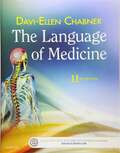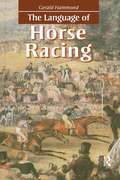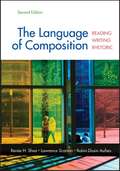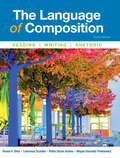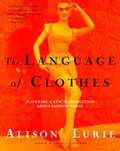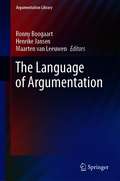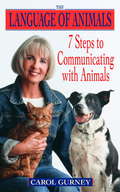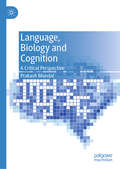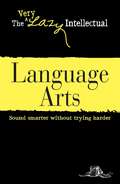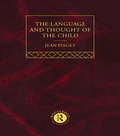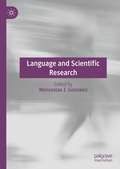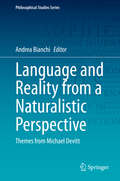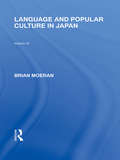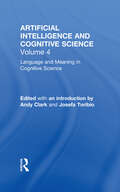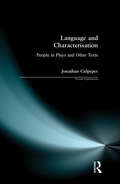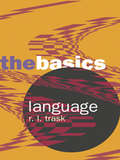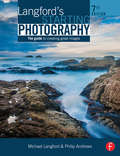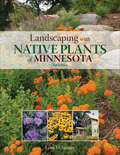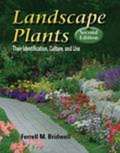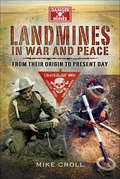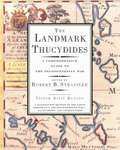- Table View
- List View
The Language Of Medicine
by Davi-Ellen ChabnerBring medical terminology to life with Davi-Ellen Chabner's bestselling The Language of Medicine, 11th Edition! An illustrated, easy-to-understand approach presents medical terms within the context of the body’s anatomy and physiology, and in health and disease. With this proven resource, you’ll learn a working medical vocabulary built on the most frequently encountered prefixes, suffixes, and combining forms. Practical exercises and case studies make learning more interesting and demonstrate how medical terms are used in practice. Take advantage of interactive activities, games, quizzes, and flash cards on the Evolve companion website, and you will be ready to communicate fluently in the clinical setting and succeed in your healthcare career.
The Language of Law and the Foundations of American Constitutionalism
by Gary L. McdowellFor much of its history, the interpretation of the United States Constitution presupposed judges seeking the meaning of the text and the original intentions behind that text, a process that was deemed by Chief Justice John Marshall to be "the most sacred rule of interpretation. " Since the end of the nineteenth century, a radically new understanding has developed in which the moral intuition of the judges is allowed to supplant the Constitution's original meaning as the foundation of interpretation. The Founders' constitution of fixed and permanent meaning has been replaced by the idea of a "living" or evolving constitution. Gary L. McDowell refutes this new understanding, recovering the theoretical grounds of the original Constitution as understood by those who framed and ratified it. It was, he argues, the intention of the Founders that the judiciary must be bound by the original meaning of the Constitution when interpreting it.
The Language of Law and Economics
by Francesco ParisiFrom a historical perspective, 'law and economics' constituted one of the most influential developments in legal scholarship in the twentieth century; the discipline remains today one of the dominant perspectives on the law, generating a tremendous quantity of new research and discussion. Unfortunately, one consequence of applying the analytical methods of one highly technical field to the historically layered substance of another has been the accumulation of considerable technical overhead, requiring fluency in both the language of economics and the language of the law. Further complicating matters, the field of law and economics has sometimes developed independently, creating new terms, while recasting others from their original economic or legal meanings. In this dictionary of law and economics, Francesco Parisi provides a comprehensive and concise guide to the language and key concepts underlying this fecund interdisciplinary tradition. The first reference work of its kind, it will prove to be an invaluable resource for professionals, students and scholars.
The Language of Horse Racing
by Gerald HammondIn dictionary form but offering much more than dictionary definitions, The Language of Horse Racing presents a guide to the history, development and usage of words and phrases employed on the racecourse, by those who train and look after horses, those who ride them, and those who lose their money betting on them. Here the reader will discover exactly what the distance is, and why it is so called; what the cap was in handicap; what relation the wild goose chase had to the steeple-chase; what is dead about a dead heat; and what the differences are between getting in, getting on, getting out and getting up. The Language of Horse Racing also reveals the language of the racecourse, including the bizarre vocabulary of betting, from the betting boots that early bookies put on, to the faces, heads, sharks and sharps who feed off the buzz and whisper that go round the ring.
The Language Of Composition: Reading, Writing, Rhetoric
by Lawrence Scanlon Robin Aufses Renee SheaThe Language of Composition is the first textbook built from the ground up to help students succeed in the AP English Language course. Written by a team of experts with experience in both high school and college, this text focuses on teaching students the skills they need to read, write, and think at the college level. With practical advice and an extensive selection of readings -- including essays, poetry, fiction, and visual texts --The Language of Composition helps students develop the key skills they must master to pass the course, to succeed on the AP Exam, and to prepare for a successful college career. Revised based on feedback from teachers across the country, the second edition promises to be an even better resource for the AP Language classroom.
The Language of Composition: Reading, Writing, Rhetoric
by Renée H. Shea Lawrence Scanlon Robin Dissin Aufses Megan Harowitz PankiewiczFor over a decade, The Language of Composition has been the most successful textbook written for the AP® English Language and Composition Course. Now, its esteemed author team is back, giving practical instruction geared toward training students to read and write at the college level. The textbook is organized in two parts: opening chapters that develop key rhetoric, argument, and synthesis skills; followed by thematic chapters comprised of the finest classic and contemporary nonfiction and visual texts. With engaging readings and reliable instruction, The Language of Composition gives every students the opportunity for success in AP® English Language.
The Language of Clothes
by Alison Lurie Doris PalcaThe classic book about the clothes we wear and what they say about us. Even before we speak to someone in a meeting, at a party, or on the street, our clothes often express important information (or misinformation) about our occupation, origin, personality, opinions, and tastes. And we pay close attention to how others dress as well; though we may not be able to put what we observe into words, we unconsciously register the information, so that when we meet and converse we have already spoken to one another in a universal tongue. Alison Lurie, the Pulitzer Prize-winning novelist, is our savvy guide and interpreter on this tour through the history of fashion. She provides fascinating insights into how changing sex roles, political upheavals, and class structure have influenced costume. Whether she is describing the enormous amount of clothing worn by early Victorian women or illuminating the significance of the long robes worn by aging men throughout history to connote eminence, her analysis is playful, clever, and always on target.
The Language of Argumentation (Argumentation Library #36)
by Ronny Boogaart Henrike Jansen Maarten Van LeeuwenBringing together scholars from a broad range of theoretical perspectives, The Language of Argumentation offers a unique overview of research at the crossroads of linguistics and theories of argumentation.In addition to theoretical and methodological reflections by leading scholars in their fields, the book contains studies of the relationship between language and argumentation from two different viewpoints. While some chapters take a specific argumentative move as their point of departure and investigate the ways in which it is linguistically manifested in discourse, other chapters start off from a linguistic construction, trying to determine its argumentative function and rhetorical potential. The Language of Argumentation documents the currently prominent research on stylistic aspects of argumentation and illustrates how the study of argumentation benefits from insights from linguistic models, ranging from theoretical pragmatics, politeness theory and metaphor studies to models of discourse coherence and construction grammar.
The Language Of Animals: 7 Steps to Communicating with Animals
by Carol GurneyA Step-by-Step Program for Communicating With Your Animals The human/animal spiritual connection is a powerful one. In this astounding guide, renowned animal communicator Carol Gurney draws upon fifteen years of successful communication with animals to offer animal lovers what they’ve always longed for: a simple, effective method for “listening to” and communicating with their animals. Based on her successful 7-step HeartTalk ProgramSM, which has already helped thousands of people understand their basic telepathic connection with animals, Gurney outlines the principles of “heart-to-heart” communication, showing you how to open your heart to a more meaningful connection with the animals you love. Learn how to: * Understand your animal’s needs, feelings, and innermost thoughts so you can discover who he or she really is * Develop long-distance communication skills to locate lost or stolen animals * Understand animals’ physical feelings so you can help comfort them when they are sick or injured * Emotionally prepare yourself for the death of your beloved animal * Discover how animals can be your best teachers in helping you to love yourself * Actually communicate telepathically with the loving beings that share your world! Animals are not only our loyal companions; they are our guides, our healers, our link to the simple wisdom of the natural world. Filled with amazing real-life stories of human/animal communication,The Language of Animalsis a must for every animal enthusiast–and a loving gift to the engaging, expressive animals who have so much to share. From the Trade Paperback edition.
Language in the Law
by V. Prakasam John Carey John Gibbons K. V. TirumaleshThe Language in the Law records the different modes and practices in the use of language related to law. The nexus between language and the law in various countries and cultures is examined in this book.
Language, Biology and Cognition: A Critical Perspective
by Prakash MondalThis book examines the relationship between human language and biology in order to determine whether the biological foundations of language can offer deep insights into the nature and form of language and linguistic cognition. Challenging the assumption in biolinguistics and neurolinguistics that natural language and linguistic cognition can be reconciled with neurobiology, the author argues that reducing representation to cognitive systems and cognitive systems to neural populations is reductive, leading to inferences about the cognitive basis of linguistic performance based on assuming (false) dependencies. Instead, he finds that biological implementations of cognitive rather than the biological structures themselves, are the driver behind linguistic structures. In particular, this book argues that the biological roots of language are useful only for an understanding of the emergence of linguistic capacity as a whole, but ultimately irrelevant to understanding the character of language. Offering an antidote to the current thinking embracing ‘biologism’ in linguistic sciences, it will be of interest to readers in linguistics, the cognitive and brain sciences, and the points at which these disciplines converge with the computer sciences.
Language Arts: Sound smarter without trying harder (The Very Lazy Intellectual)
by Adams MediaDo great works of literature confound you? Can you not tell the difference between Expressionism and Impressionism? Fear not! The Very Lazy Intellectual: Language Arts delves into the speech, composition, and literature of modern culture. With information on everything to etymology, to literary criticism, to myriad literary styles, you'll have everything you need to be modern-day Bill Shakespeare.
Language and Thought of the Child: Selected Works vol 5 (Routledge Classics Ser.)
by Jean PiagetJean Piaget was one of the most salient and inspirational figures in psychological and educational research of the 20th century. He was also prolific, authoring or editing over 80 books and numerous journals and papers which spawned a continuation of his work over the following decades. His work now compromises a major component of many courses on children's psychological development and in a research tradition which is expanding, scholars may need access to the original texts rather than secondhand accounts. This volume is the sixth of nine reproducing Piaget's original works - they are also available as a boxed set.
Language and Scientific Research
by Wenceslao J. GonzalezThis book analyzes the role of language in scientific research and develops the semantics of science from different angles. The philosophical investigation of the volume is divided into four parts, which covers both basic science and applied science: I) The Problem of Reference and Potentialities of the Language in Science; II) Language and Change in Scientific Research: Evolution and Historicity; III) Scientific Language in the Context of Truth and Fiction; and IV) Language in Mathematics and in Empirical Sciences. Language plays a key role in science: our access to the theoretical, practical or evaluative dimensions of scientific activity begins with the mastery of language, continues with a deepening in the use of language and reaches the level of contribution when it creates new terms or changes them in sense and reference. This reveals the compatibility between objectivity in semantic contents and historicity in the progress of science. This volume is a valuable enrichment to students, academics and other professionals interested in science in all its forms, who seek to deepen the role that language plays in its structure and dynamics.
Language and Reality from a Naturalistic Perspective: Themes from Michael Devitt (Philosophical Studies Series #142)
by Andrea BianchiThis book celebrates the many important contributions to philosophy by one of the leading philosophers in the analytic field, Michael Devitt.It collects seventeen original essays by renowned philosophers from all over the world. They all develop themes from Devitt’s work, thus discussing many fundamental issues in philosophy of linguistics, theory of reference, theory of meaning, methodology, and metaphysics.In a long final chapter, Devitt himself replies to the contributors. In so doing, he further elaborates his views on various of these issues, for example defending his claim (in opposition to Chomskyan orthodoxy) that languages are external rather than internal; his well-known causal theory of reference; his “shocking” idea that meanings can be causal, non-descriptive, modes of presentation; his methodological naturalism; his commitment to scientific realism; and his version of biological essentialism. The volume will appeal to all scholars and students interested in contemporary theoretical analytic philosophy, and will be a must-read for any serious researcher in philosophy of language. It provides a deep insight into the work of one of the most important living philosophers, and will help readers to better understand language and reality from a naturalistic perspective.
Language and Popular Culture in Japan (Routledge Library Editions: Japan)
by Brian MoeranWhen this book was originally published it was the first work of its kind to examine the way in which language is used to express the ‘myth’ of advertising slogans and other popular cultural forms. By making use of general theories from the disciplines of anthropology, linguistics, media studies and semiotics, the book attempts to demystify Japanese culture as it has been hitherto presented in the West, and shows how such cultural forms as ‘noodle westerns’ and high-school baseball uphold the well-known ideologies of ‘selflessness’, ‘diligence’, ‘compliance’ and ‘co-operation’ typically associated with the Japanese. Ultimately, the book poses the question: are those whom we call the Japanese ‘real’ people in their own right, or merely a nation acting out a part written for them by Western civilisation?
Language and Meaning in Cognitive Science: Cognitive Issues and Semantic theory (Artificial Intelligence And Cognitive Science Ser.)
by Andy Clark Josefa ToribioSummarizes and illuminates two decades of researchGathering important papers by both philosophers and scientists, this collection illuminates the central themes that have arisen during the last two decades of work on the conceptual foundations of artificial intelligence and cognitive science. Each volume begins with a comprehensive introduction that places the coverage in a broader perspective and links it with material in the companion volumes. The collection is of interest in many disciplines including computer science, linguistics, biology, information science, psychology, neuroscience, iconography, and philosophy. Examines initial efforts and the latest controversiesThe topics covered range from the bedrock assumptions of the computational approach to understanding the mind, to the more recent debates concerning cognitive architectures, all the way to the latest developments in robotics, artificial life, and dynamical systems theory. The collection first examines the lineage of major research programs, beginning with the basic idea of machine intelligence itself, then focuses on specific aspects of thought and intelligence, highlighting the much-discussed issue of consciousness, the equally important, but less densely researched issue of emotional response, and the more traditionally philosophical topic of language and meaning. Provides a gamut of perspectives The editors have included several articles that challenge crucial elements of the familiar research program of cognitive science, as well as important writings whose previous circulation has been limited. Within each volume the papers are organized to reflect a variety of research programs and issues. The substantive introductions that accompany each volume further organize the material and provide readers with a working sense of the issues and the connection between articles.
Language and Characterisation: People in Plays and Other Texts (Textual Explorations)
by Jonathan CulpeperTextual Explorations General Editors-Mick Short, Lancaster UniversityElena Semino, Lancaster UniversityThe focus of this series is on the stylistic analysis of literary and non-literary texts, and the theoretical issues which such work raises. Textual Explorations will include books that cover studies of literary authors, genres and other groupings, stylistic studies of non-literary texts, translation study, the teaching of language and literature, the empirical study of literature, and corpus approaches to stylistics and literature study. Books in the series will centre on texts written in English. Readership of the series is mainly undergraduate and postgraduate students, although advanced sixth formers will also find the books accessible. The series will be of particular interest to those who study English language, English literature, text linguistics, discourse analysis and communication studies. Language & Characterisation- People in Plays & Other Texts explores how the words of a text create a particular impression of a character in the reader's mind. Drawing together theories from linguistics, social cognition and literary stylistics, it is the first book-length study to focus on: the role of language and characterisation characterisation in the dialogue of play texts Containing numerous examples from Shakespeare's plays, the book also considers a wide range of other genres, including, prose fiction, verse, films, advertisements, jokes and newspapers. Language and Characterisation is as practical as it is theoretical and equips readers with analytical frameworks to reveal and explain both the cognitive and the linguistic sides of characterisation. Clear and detailed introductions are given to the theories, and useful suggestions for further analysis are also made at the end of each part of the book. The book will be essential reading for students and researchers of language, literature and communication.
Language: The Basics (The Basics)
by R.L. TraskWhat makes human language unique?Do women speak differently from men?Just what is the meaning of "meaning"?Language: The Basics provides a concise introduction to the study of language. Written in an engaging and entertaining style, it encourages the reader to think about the way language works. It features: * chapters on 'Language in Use', 'Attitudes to Language', 'Children and Language' and 'Language, Mind and Brain'* a section on sign language* a glossary of key terms* handy annotated guides to further reading.Providing an accessible overview of a fascinating subject, this is an essential book for all students and anyone who's ever been accused of splitting an infinitive.
Langford's Starting Photography: The Guide to Creating Great Images
by Philip AndrewsStarting with the basics of camera control and moving on to shutter speeds, aperture, zoom and flash, Langford’s Starting Photography gives you the only introduction to digital photography you’ll ever need. Once you’ve mastered the basics, examples and projects allow you to explore the key methods for capturing a variety of subjects from portraits and pets to landscapes and sports photography, alongside straightforward advice on using editing software to get the best out of your digital shots, will have you producing unforgettable images in moments. More inspiring than a textbook, more interesting than a reference, and more in-depth than a photography class, Langford’s Starting Photography is the only guide you need to start taking great images.
Landscaping with Native Plants of Minnesota
by Lynn M. SteinerAn updated guide to Minnesota’s hardy native plants and how to incorporate them into your home landscape—with profiles of flowers, trees, shrubs, and more.Gardeners enjoy Minnesota’s native plants for more than their beauty. They are low maintenance, can survive difficult soil and weather conditions, provide unique landscape options, and celebrate the state’s natural heritage. In this second photo-filled edition of Landscaping with Native Plants of Minnesota, you’ll learn how to identify native plants, keep them healthy and thriving in the state’s harsh climate, and design and install an attractive home landscape perfect for your lifestyle. Also included in this new edition are comprehensive plant profiles and gardening essentials for approximately 350 native flowers, trees, shrubs, vines, evergreens, grasses, and ferns that grew in Minnesota before European settlement, as well as complete information on planting, maintenance, and landscape uses for each plant.
Landscaping Earth Ponds
by Tim MatsonThe guru of earth ponds explains how to site, design, shape, and plant these beloved fixtures of rural landscapes-and make them fit your property and your life. In the decades since he wrote his acclaimed "Earth Ponds," Tim Matson has designed scores of ponds, each unique to its site and its owners. In "Landscaping Earth Ponds," he shares what he has learned to make these captivating ponds truly fit into their landscapes and into the lives and lifestyles of their owners. Ponds have long been valued for their charm and utility: how else can you simultaneously enliven your landscape, create recreational opportunities, help the environment, and increase your property value? Earth ponds are increasingly recognized for the full range of gardening, landscaping, and ecological promise they hold. As pond-building methods have been perfected, more homeowners are restoring existing ponds or digging new ones. With dozens of color photographs, Matson shows you how to site a pond in right relation to your house, offering surprisingly simple ways to visually link the two. His proven methods and designs reflect the many moods water evokes. Screen your pond for privacy, create a sandy beach and natural diving platform, encourage wetland gardens, line the shores with moisture-loving perennials, or design your gardens and paths to create a sense of mystery and adventure.
Landscape Plants: Their Identification, Culture, and Use (2nd edition)
by Ferrell M. BridwellIntended to help students, nursery people, landscape architects, educators, and homeowners in accurately identifying and growing an array of mostly typical woody landscape plants. A beginning chapter discusses plant identification and characteristics as well as the functional and aesthetic uses of plants. The remaining chapters present the plants, with one page of text and several passable color photos devoted to each. Information provided includes hardiness zones (mostly USDA zones 5 to 9), dimensions, fruit, texture, growth rate, culture, pest problems, habit, family, leaf and flower characteristics, selections and cultivars in cultivation, and landscape notes. Entries include ground covers; vines; dwarf, medium, and large shrubs; small, medium, and large trees; and grasses, palms, and bamboo.
Landmines in War and Peace: From Their Origin to Present Day (Danger Mines)
by Mike CrollLand mines and their antecedents have been used on the battlefield from ancient times, through the world wars, to the modern conflicts in the developing world. Their use in the developing world caused tens of thousands of civilian casualties, and the resulting international outrage transformed rapidly into a highly effective global movement to ban land mines and a multi million dollar mine action business. This book describes how technology and military tactics defined land mine development and deployment, why they are such an effective weapon of war, and how an unlikely alliance of soldiers, peace activists, development workers and celebrities succeeded in banning the use of antipersonnel mines. Comparisons are made between the post WW2 clearance of around 100 million land mines in Europe and contemporary efforts to clear a similar number in the developing world. By 1947 Europe was largely mine free, yet after nearly 20 years and expenditure of $4 billion the land mine crisis in the developing world continues. The elusive search for the easy way to clear mines is described. Despite experiments with machines, airships, rats and explosive clearance methods, mine clearance remains a hazardous, labor-intensive task undertaken by teams of deminers using metal detectors and needle-like probes.
The Landmark Thucydides: A Comprehensive Guide to the Peloponnesian War
by Robert B. Strassler Victor Davis HansonThucydides called his account of two decades of war between Athens and Sparta "a possession for all time," and indeed it is the first and still most famous work in the Western historical tradition. Considered essential reading for generals, statesmen, and liberally educated citizens for more than 2,000 years, The Peloponnesian War is a mine of military, moral, political, and philosophical wisdom. However, this classic book has long presented obstacles to the uninitiated reader. Robert Strassler's new edition removes these obstacles by providing a new coherence to the narrative overall, and by effectively reconstructing the lost cultural context that Thucydides shared with his original audience. Based on the venerable Richard Crawley translation, updated and revised for modern readers. The Landmark Thucydides includes a vast array of superbly designed and presented maps, brief informative appendices by outstanding classical scholars on subjects of special relevance to the text, explanatory marginal notes on each page, an index of unprecedented subtlety, and numerous other useful features. In any list of the Great Books of Western Civilization, The Peloponnesian War stands near the top. This authoritative new edition will ensure that its greatness is appreciated by future generations.
